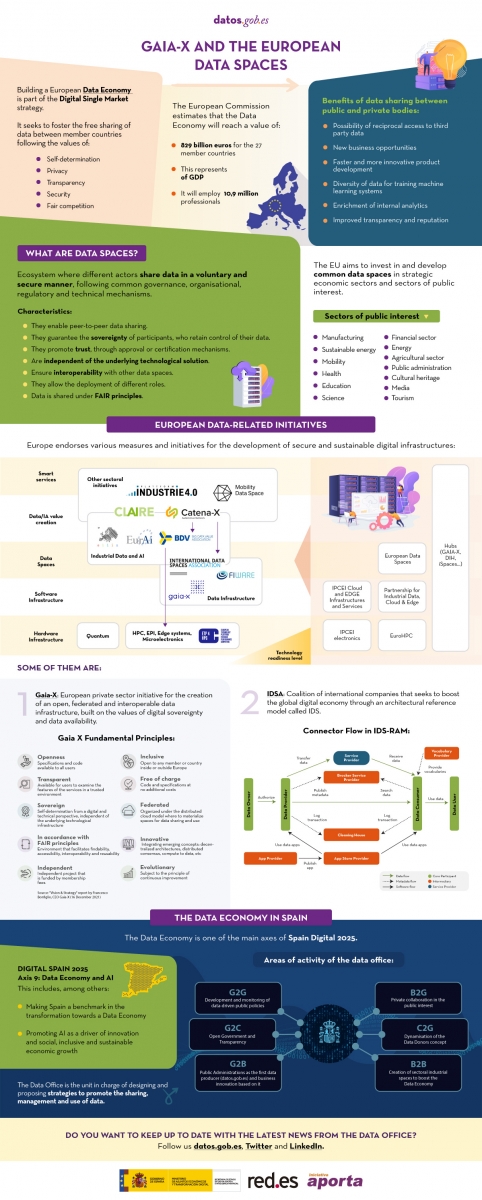The Council of Ministers approved in February this year the Sustainable Mobility Bill (PL), a commitment to a digital and innovative transport system in which open mobility data will play a key role.
Inaddition to regulating innovative solutions such as on-demand transport, car sharing or temporary use of vehicles, the regulation will encourage the promotion ofopen data by administrations, infrastructure managers and public and private operators. All this, as stated in Chapter III Title V of the Draft Law "will bring enormous benefits to citizens, e.g. for new mobility and their contribution to the European Green Pact".
This Bill is aligned with the European Data Strategy, which has among its objectives to create a single market for data that ensures Europe' s global competitiveness and data sovereignty through the creation of common European data spaces common European data spaces in nine strategic sectors. In particular, it foresees the creation and development of a common European mobility data space to put Europe at the forefront of the development of a smart transport system, including connected cars and other modes of transport. Along these lines, the European Commission presented its Sustainable and Intelligent Mobility Strategywhich includes an action dedicated to innovation, data and artificial intelligence for smarter mobility. Following in Europe's footsteps, Spain has launched this Sustainable Mobility Bill.
In this post we look at the benefits that the use of open data can bring to the sector, the obligations that the PL will place on data, and the next steps in building the Integrated Mobility Data Space.
Benefits of using open data on sustainable mobility
The Ministry of Transport and Sustainable Mobility, in the web section created for the Law, identifies some of the benefits that access to and use of open transport and mobility data can offer both to the business community and to public administrations and citizens in general:
- Encourage the development of applications that enable citizens to make decisions on the planning of their journeys and during the course of their journeys.
- Improve the conditions of service provision and the travel experience .
- Incentivise research, create new developments and businesses from the data generated in the transport and mobility ecosystem.
- Enable public administrations to have a better understanding of the transport and mobility system in order to improve the definition of public policies and the management of the system.
- Encourage the use of this data for other public interest purposes that may arise.

Ensuring access to open mobility data
In order to make good use of these data and thus take advantage of all the benefits they offer, the Draft Law determines a strategy to ensure the availability of open data in the field of transport and mobility. This strategy concerns:
- transport companies and infrastructure managers, which must drive digitalisation and provide a significant part of the data, with specific characteristics and functionalities.
- administrations and public entities were already obliged to ensure the openness of their data by design, as well as its re-use on the basis of the already existing
In short, the guidelines for re-use already defined in Law 37/2007 for the public sector are respected, and the need to regulate access to this information and the way in which this data is used by third parties, i.e. companies in the sector, is also included.
Integrated Mobility Data Space
In line with the European Data Strategy mentioned at the beginning of the post, the PL determines the obligation to create the Integrated Mobility Data Space (EDIM) under the direction of the Ministry of Transport and Sustainable Mobility, in coordination with the Secretary of State for Digitalisation and Artificial Intelligence. In the EDIM, the aforementioned transport companies, infrastructure managers and administrations will share their data, which will optimise the decision making of all actors when planning the implementation of new infrastructures and the launch of new services.
The Draft Law defines some characteristics of the Integrated Mobility Data Space such as the modular structure, which will include information in a systematic way on different areas of urban, metropolitan and interurban mobility, both for people and goods.
Specifically, the EDIM, according to Article 14, would collect data "in digital form in a free, non-discriminatory and up-to-date manner" on:
- Supply and demand of the different modes of transport and mobility, information on public transport services and mobility services under the responsibility of the administrations
- Financial situation and costs of providing services for all modes of public transport, investments in transport infrastructure, inventory of transport infrastructure and terminals, conditions and degree of accessibility.
- Other data to be agreed at the Sectoral Conference on Transport.
It identifies examples of this type of data and information on the responsibility for its provision, format, frequency of updating and other characteristics.
As referred to in the CP, the data and information managed by the EDIM will provide an integrated vision to analyse and facilitate mobility management, improving the design of sustainable and efficient solutions, and transparency in the design of public transport and mobility policies. In addition, the Law will promote the creation of a sandbox or test environment to serve as an incubator for innovative mobility projects. The outcome of the tests will allow both the developer and the administration to learn by observing the market in a controlled environment.
National Bimodal Transport Access Point
On the other hand, the Bill also provides for the creation of a National Bimodal Transport Access Point that will collect the information communicated to the Ministry of Transport and Sustainable Mobility in the framework of the priority action "Provision of information services on multimodal journeys throughout the Union" of Directive 2010/40/EU which refers to the transport of goods and/or persons by more than one means of transport.
This information will be freely accessible and will also serve to feed the EDIM in the area related to the characterisation of transport and mobility of persons, as well as the National Catalogue of Public Information maintained by the General State Administration.
The Bill defines that the provision of services to citizens using transport and mobility data from the National Multimodal Transport Access Point must be done in a fair, neutral, impartial, non-discriminatory and transparent manner. It adds that the Ministry of Transport and Sustainable Mobility will propose rules for the use of such data within 12 months after the entry into force of this law.
The Sustainable Mobility Bill is currently in parliamentary procedure, as it has been sent to the Spanish Parliament for urgent processing and approval in 2024.
The Implementing Regulation (EU) 2023/138 of the European Commission sets clear guidelines for public bodies on the availability of high-value datasets within 16 months. These high-value datasets are grouped into the following themes, which were already described in this post post:
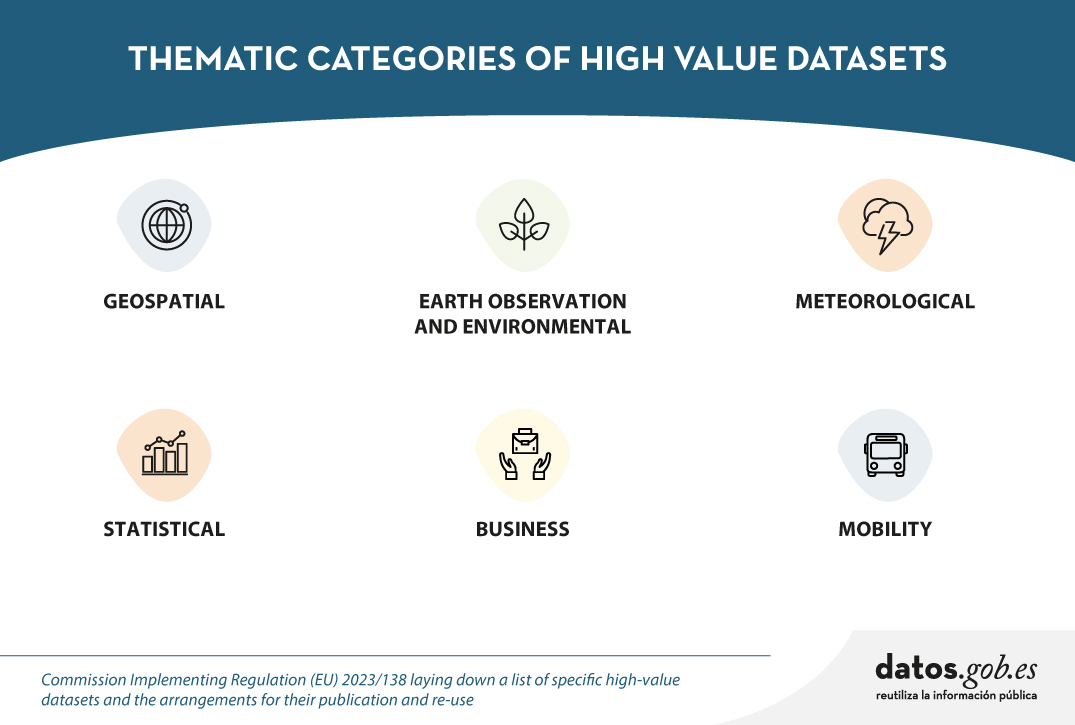
This article focuses on the geospatial category, called High-Value Geospatial Datasets (HVDG).
For all HVDGs, the following shall apply Directive 2007/2/EC of the European Parliament and of the Council of 14 March 2007 establishing an infrastructure for spatial information in the European Community (INSPIRE) with the exception of agricultural and reference parcels, for which Regulation (EU) 2021/211/EEC applies Regulation (EU) No 2021/2116 of the European Parliament and of the Council of 2 December 2021.
As reflected in the table below, the regulation provides detailed information on the requirements to be considered for these HVDGs, such as scales or granularity and attributes of each dataset. These are complementary to the attributes defined in the European Regulation (No 1089/2010), which establishes the interoperability of spatial data sets and services.
| Datasets | Scales | Attributes |
|---|---|---|
| Administrative units |
Levels of generalisation available with a granularity down to the scale of 1:5 000. From municipalities to countries; maritime units. |
|
| Geographical names |
Not applicable. |
|
| Directorates | Not applicable. |
|
| Buildings | Levels of generalisation available with a granularity up to the scale of 1:5 000 |
|
| Cadastral parcels | Levels of generalisation available with a granularity up to the scale of 1:5 000 |
|
| Reference areas | Levels of generalisation available with a granularity up to the scale of 1:5 000 |
|
| Agricultural areas | Level of accuracy equivalent to 1:10 000 scale and from 2016, 1:5 000 scale |
|
To ensure the accessibility and re-use of all these valuable datasets, it is imperative to follow certain provisions to facilitate their publication. Here are the key requirements:
- Open Licence: All datasets must be made available for re-use under a licence Creative Commons BY 4.0 or any equivalent less restrictive open licence. This encourages the freedom to share and adapt information.
- Open and Machine Readable Format: Data should be presented in an open, machine-readable format and be publicly documented. This ensures that the information is easily understandable and accessible to any person or automated system.
- Application Programming Interfaces (APIs) and Mass Download: Application programming interfaces (APIs) should be provided to facilitate programmatic access to data. In addition, direct bulk downloading of datasets should be possible, allowing flexible options for users according to their needs.
- Updated version: The availability of datasets in their most up-to-date version is essential. This ensures that users have access to the latest information, promoting the relevance and accuracy of data.
- Metadata: The description of the data will also be carefully taken care of through the use of metadata. This metadata shall, as a minimum, include the elements as defined in Commission Regulation (EC) No 1205/2008 of 3 December 2008. This regulation implements Directive 2007/2/EC of the European Parliament and of the Council and sets standards for metadata associated with datasets. The use of standardised metadata provides additional information essential for understanding, interpreting and using datasets effectively. By following these standards, interoperability and consistency in reporting is facilitated, thus promoting a more complete and accurate understanding of the available data.
These provisions not only promote transparency and openness, but also facilitate collaboration and the effective use of information in a variety of contexts.
Does Spain comply with the Geospatial HVD Regulation?
The INSPIRE (Infrastructure for Spatial Information in Europe) Directive determines the general rules for the establishment of an Infrastructure for Spatial Information in the European Community based on the Infrastructures of the Member States. Adopted by the European Parliament and Council on 14 March 2007 (Directive 2007/2/EC), entered into force on 25 April 2007.
INSPIRE makes it easier to find, share and use spatial data from different countries and in each of the regions, with HVDs available in the the Commission's new catalogue of HVDs and in each of the catalogues of the Spatial Data Infrastructures of the Autonomous Communities, as well as in the Official INSPIRE Data and Services Catalogue of Spain. The information is available through an online platform whit data from different countries.
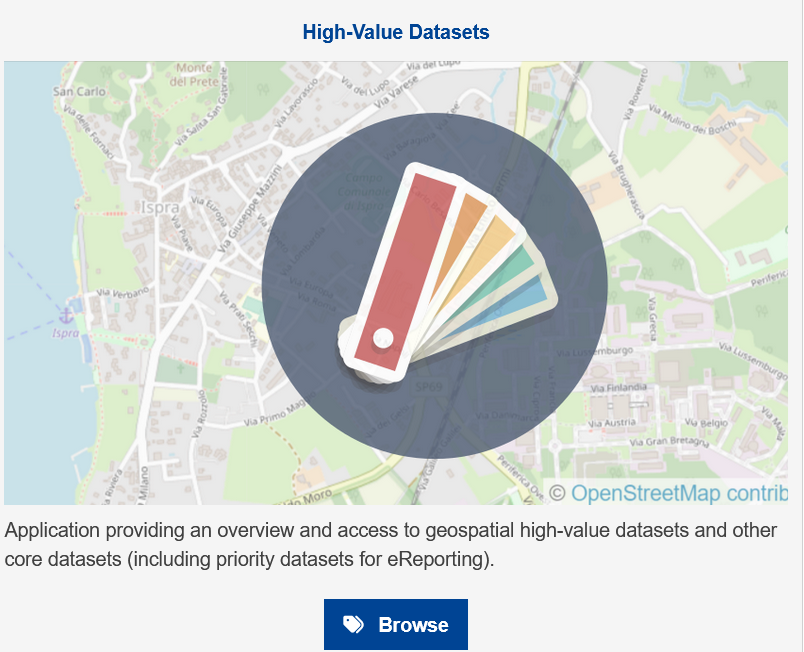
WARNING!: They are currently working on this Geoportal carrying out the tasks of data dump, therefore, there may be some temporal inconsistency with the data provided, which correspond to the Official Catalogue of INSPIRE Data and Services (CODSI).
In Spain, we can find the Law 14/2010 of 5 July 2010 on geographic information infrastructures and services in Spain (LISIGE), which transposes Directive 2007/2/EC INSPIRE. This law frames the work to make all national spatial data available and obliges the adaptation of national spatial data to the Technical Guides or Guidelines collected by the INSPIRE Directive, thus ensuring that these data are compatible and interoperable in a Community and cross-border context.
LISIGE applies to geographic data that meet these conditions:
- Refering to a geographical area of the national territory, the territorial sea, the contiguous zone, the continental shelf and the exclusive economic zone.
- Having been generated by or under the responsibility of public administrations.
- Being in electronic format.
- Their production and maintenance is the responsibility of a public sector administration or body.
- Being within the themes of Annexes I (Geographic Reference Information), II (Fundamental Thematic Data) or III (General Thematic Data) referred to in the aforementioned law
Furthermore, it is clarified that the geographic data and services regulated by the LISIGE will be available on the NSDI Geoportal and on the CODSI as well as in the rest of the catalogues of the Autonomous Communities. The National Geographic Institute (IGN) is responsible for its maintenance.
Thanks to the tireless efforts of the entire Spanish administration since the publication of LISIGE, Spain has achieved a remarkable milestone. It is currently available on the INSPIRE Geoportal a wide range of information classified as High Value Geospatial Data Set (HVDG) is now available on the INSPIRE Geoportal. This achievement reflects our country's continued commitment to transparency and access to high quality geospatial data.
As of January 2024 Spain has published in the INSPIRE Geoportal and in CODSI the following information related to the High Geospatial Value Datasets (HVD)
- 31 datasets associated with their metadata
- 34 download services (WFS, ATOM Feed, OGC Api Feature)
- 28 visualisation services (WMS, WMTS)
Analysing the sets of high geospatial value we see that, according to the thematics, they have already been published:
| HVDG Spain | Datasets | Download services | Visualisation services | Covers Spanish territory |
|---|---|---|---|---|
| Administrative units |
5 | 7 | 7 | Sí |
| Geographical names |
7 | 8 | 8 | Sí |
| Directorates | 6 | 5 | 7 | Sí |
| Buildings | 5 | 3 | 4 | Sí |
| Cadastral parcels | 3 | 3 | 3 | Sí |
| Reference areas | 3 | 0 | 3 | Sí |
| Agricultural areas | 2 | 2 | 2 | Sí |
Spain currently complies with the HVDG Regulation in all categories. Specifically, it complies with the established legislation at the level of scale or granularity, attributes, license, format, availability of the data in API or maximum download, with being the most updated version and with the metadata.
A detailed analysis of the datasets published under the HVD framework highlights several key issues:
- Comprehensive Geographic Coverage: At least one dataset covering the whole of Spain has been made available.
- Comprehensive Metadata: Metadata has been generated for all High Geospatial Value Datasets (HVDGs). These metadata are published in the Official INSPIRE Catalogue of INSPIRE Data and Services (CODSI), validated to comply with the standards of the Commission Regulation (EC) No 1205/2008.
- Viewing and Downloading Services: All HVDGs have viewing and download services. Download services can be bulk download or download APIs. Currently, they are WFS and ATOM. In the future may be OGC API Feature or API Coverage.
- Open Licences and Open Formats: All published services are licensed under Creative Commons BY 4.0, and download services use standard and open formats such as the GML format documented by the international standard ISO 19136.
- Compliance with INSPIRE Data Models: Almost all datasets comply with the INSPIRE data models, thus ensuring the consistency and quality of the attributes set out in the HVDG regulation.
- Data Updated and Maintained: Download services guarantee the availability of data in the most up-to-date version. Each public administration responsible for the data is responsible for maintaining and updating the information.
This analysis highlights the commitment and efficiency in the management of geospatial data in Spain, contributing to the transparency, accessibility and quality of the information provided to the community.
It should be noted that, in Spain, all HVDG requirements are met. Organisations such as the CNIG and the ICGC or the Government of Navarre, in addition to publishing through WFS or ATOM services, are already working on publishing these datasets with the APIs of OGC.
The INSPIRE Geoportal has become a valuable source of information, thanks to the dedication and collaboration of various governmental entities, including Spanish ones. This breakthrough not only highlights progress in the implementation of geospatial standards, but also strengthens the basis for sustainable development and informed decision-making in Spain. A significant achievement for the country in the geospatial field!
Content prepared by Mayte Toscano, Senior Consultant in Data Economy Technologies. The contents and points of view reflected in this publication are the sole responsibility of its author.
The Multisectorial Association of Information (ASEDIE), which brings together the infomediary companies of our country, once again includes among its annual objectives the promotion of the reuse of public and private information. Thus, and almost in parallel to the beginning of the new year, last December, ASEDIE shared the progress that the top 3 has experienced in most of the autonomous communities, and the good expectations for the second edition.
Since this initiative was launched last 2019 to promote the opening of three datasets by the autonomous communities, they have been gradually opening datasets that have improved access to information sources, while helping to boost the development of services and applications based on open data. The objective of this project, which in 2021 was included as a commitment to Best Practices in the Observatory of the IV Open Government Plan and supported by the seventeen Autonomous Communities, is to harmonize the opening of Public Sector databases with the aim of encouraging their reuse, promoting the development of the data economy.
First edition: accessible in fifteen autonomous communities
The first edition of Asedie's Top 3 was a success not only because of the datasets selected, but also because of the openness rate achieved four years later. Currently, fifteen of the country's seventeen autonomous communities have managed to open all three databases to the general public: cooperatives, foundations and associations.
2023: the year to complete the opening of the second edition
With the aim of continuing to promote the opening of public information in the different autonomous communities, in 2020, ASEDIE launched a new edition of the top 3 so that those communities that had already overcome the previous challenge could continue to make progress. Thus, for this second edition the selected databases were the following:
- Energy Efficiency Certificates
- Industrial Estates
- Agricultural Transformation Companie
As a result, the second edition of the top 3 is now accessible in seven autonomous communities. Moreover, the databases related to energy efficiency certificates, an increasingly required information at European level, are now openly available in all the autonomous communities of the Spanish geography.
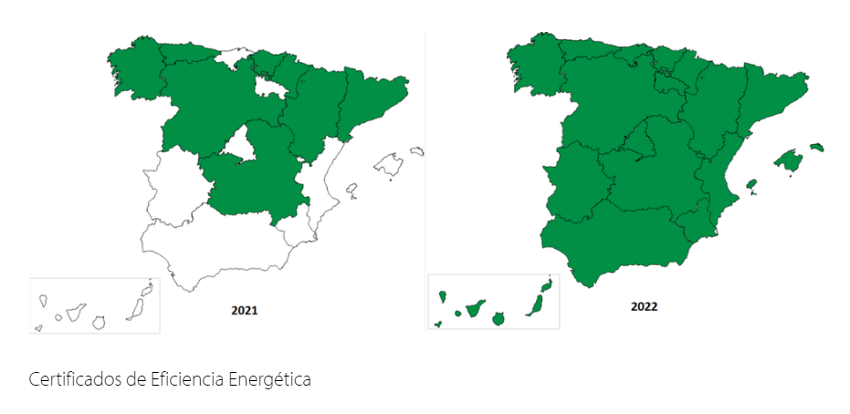
Next steps: extending the commitment to open data
As it could not be otherwise, one of ASEDIE's main annual objectives is to continue promoting regional collaboration in order to complete the opening of the second edition of the top 3 in the rest of the autonomous communities. In parallel, the next edition of the ASEDIE Report will be made public on March 22, taking advantage of the Open Administration Week. As on other occasions, this document will serve to take stock of the milestones achieved in the previous year, as well as to list the new challenges.
In fact, in relation to open data, the ASEDIE report is a very useful tool when it comes to broadening knowledge in this area of expertise, as it includes a list of successful cases of infomediary companies and examples of the products and services they produce.
In short, thanks to initiatives such as those developed by ASEDIE, public-private collaboration is becoming more and more constant and tangible, making it easier for companies to reuse public information.
There are only a few days left until the end of summer and, as with every change of season, it is time to review what the last three months have brought in the Spanish open data ecosystem.
In July we learned of the latest edition of the European Commission's DESI (Digital Economy and Society Index) report, which places Spain ahead of the EU average in digital matters. Our country is in seventh position, improving two places compared to 2021. One of the areas where it performs best is in open data, where it ranks third. These good data are the result of the fact that an increasing number of organisations are committed to opening up the information they hold and more reusers are taking advantage of this data to create valuable products and services, as we will see below.
Advances in strategy and agreements to promote open data
Open data is gaining ground in political strategies at national, regional and local level.
In this regard, in July the Council of Ministers approved the draft Act on the Digital Efficiency of the Public Justice Service, an initiative that seeks to build a more accessible Justice Administration, promoting the data orientation of its systems. Among other issues, this act incorporates the concept of "open data" in the Administration of Justice.
Another example, this time at the regional level, comes from the Generalitat de Valencia, which launched a new Open Data Strategy at the beginning of the summer with the aim of offering quality public information, by design and by default.
We have also witnessed the signing of collaboration agreements to boost the open data ecosystem, for example:
- The Ajuntament de L'Hospitalet and the Universitat Politècnica de Catalunya have signed an agreement to offer training to undergraduate and master's degree students in Big Data and Artificial Intelligence, based on open data work.
- The University of Castilla la Mancha has agreed with the regional government to launch the 'Open Government' chair in order to promote higher education and research in areas such as transparency, open data or access to public information.
- The National Centre for Geographic Information (CNIG) and Asedie have signed a new protocol to improve access to geographic information, in order to promote openness, access and reuse of public sector information.
Examples of data reuse
The summer of 2022 will be remembered for the heat waves and fires that have ravaged different corners of the country. A context in which open data has demonstrated its power to provide information on the state of the situation and help in extinguishing fires. Data from Copernicus or the State Meteorological Agency (AEMET) have been used to monitor the situation and make decisions. These data sources, together with others, are also being used to understand the consequences of low rainfall and high temperatures on European reservoirs. In addition, these data have been used by the media to provide the public with the latest information on the evolution of the fires.
Firefighting based on open data has also been developed at the regional level. For example, the Government of Navarre has launched Agronic, a tool that works with Spatial Data Infrastructures of Navarre to prevent fires caused by harvesters. For its part, the Barcelona Provincial Council's open data portal has published datasets with "essential information" for the prevention of forest fires. These include the network of water points, low combustibility strips and forest management actions, used by public bodies to draw up plans to deal with fire.
Other examples of the use of open data that we have seen during this period are:
- The Environmental Radiological Surveillance Network of the Generalitat de Catalunya has developed, from open data, a system to monitor the radiation present in the environment of the nuclear power plants (Vandellòs and Ascó) and the rest of the Catalan territory.
- Thanks to the open data shared by Aragón Open Data, a new scientific article on Covid-19 has been written with the aim of finding out and identifying spatio-temporal patterns in relation to the incidence of the virus and the organisation of health resources.
- The Barcelona Open Data initiative has launched #DataBretxaWomen, a project that seeks to raise public awareness of the existing inequality between men and women in different sectors.
- Maldito dato has used open data from the statistics developed by the National Statistics Institute (INE) based on mobile positioning data to show how the population density of different Spanish municipalities changes during July and August.
- Within its Data Analytics for Research and Innovation in Health Programme, Catalonia has prioritised 8 proposals for research based on data analysis. These include studies on migraines, psychosis and heart disease.
Developments in open data platforms
Summer has also been the time chosen by different organisations to launch or update their open data platforms. Examples include:
- The Statistical Institute of Navarre launched a new web portal, with more dynamic and attractive visualisations. In the process of creation, they have managed to automate statistical production and integrate all the data in a single environment.
- Zaragoza City Council has also just published a new open data portal that offers all municipal information in a clearer and more concise way. This new portal has been agreed with other city councils as part of the 'Open Cities' project.
- Another city that already has an open data portal is Cadiz. Its City Council has launched a platform that will allow the people of Cadiz to know, access, reuse and redistribute the open data present in the city.
- The Valencian Institute of Business Competitiveness (IVACE) presented an open data portal with all the records of energy certification of buildings in the Valencian Community since 2011. This will allow, among other actions, to carry out consumption analysis and establish rehabilitation strategies.
- Aragón Open Data has included a new functionality in its API that allows users to obtain geographic data in GeoJSON format.
- The National Geographic Institute announced a new version of the earthquake app, with new features, educational content and information.
- The Ministry for Ecological Transition and the Demographic Challenge presented SIDAMUN, a platform that facilitates access to territorial statistical information based on municipal data.
- The open data portal of the Government of the Canary Islands launched a new search engine that makes it possible to locate the pages of the portal using metadata, and which allows exporting in CVS, ODS or PDF.
Some organisations have taken advantage of the summer to announce new developments that will see the light of day in the coming months, such as the Xunta de Galicia, which is making progress in the development of a Public Health Observatory through an open data platform, Burgos City Council, which will launch an open data portal, and the Pontevedra Provincial Council, which will soon launch a real-time budget viewer.
Actions to promote open data
In June we met the finalists of the IV Aporta Challenge: "The value of data for the health and well-being of citizens", the final of which will be held in October. In addition, some competitions have been launched in recent months to promote the reuse of open data, for which the registration period is still open, such as the Castilla y León competition or the first UniversiData Datathon. The Euskadi open data competition was also launched and is currently in the evaluation phase.
With regard to events, the summer started with the celebration of the Open Government Week, which brought together various activities, some of them focused on data. If you missed it, some organisations have made materials available to citizens. For example, you can watch the video of the colloquium "Open data with a gender perspective: yes or yes" promoted by the Government of the Canary Islands or access the webinar presentations to learn about the Data Office and the Aporta Initiative.
Other events that have been held with the participation of the Data Office and whose videos are public are: the National Congress on Archives and Electronic Documents and the Data Spaces as ecosystems for entities to reach further.
Finally, in the field of training, some examples of courses that have been launched these months are:
- The National Geographic Institute has launched an Inter-administrative Training Plan, with the aim of generating a common culture among all the experts in Geographic Information of the public bodies.
- Andalucía Vuela has launched a series of free training courses aimed at citizens interested in data or artificial intelligence.
International News
The summer has also brought many new developments at the international level. Some examples are:
- The beginning of the meteorological summer saw the publication of the results of the first edition of the Global Data Barometer, which measures the state of data with respect to societal issues such as Covid19 or climate.
- The 12 finalists of the Eu Datathon 2022 were also announced.
- An interactive edition of Eurostat's regional yearbook 2021 was published.
- England has developed a strategy to harness the potential of data in health and healthcare in a secure, reliable and transparent way.
This is just a selection of news among all the developments in the open data ecosystem over the last three months. If you would like to make a contribution, feel free to leave us a message in the comments or write to dinamizacion@datos.gob.es.
The pandemic situation we have experienced in recent years has led to a large number of events being held online. This was the case of the Iberian Conference on Spatial Data Infrastructures (JIIDE), whose 2020 and 2021 editions had a virtual format. However, the situation has changed and in 2022 we will be able to meet again to discuss the latest trends in geographic information.
Seville will host JIIDE 2022
Seville has been the city chosen to bring together all those professionals from the public administration, private sector and academia interested in geographic information and who use Spatial Data Infrastructures (SDI) in the exercise of their activities.
Specifically, the event will take place from 25 to 27 October at the University of Seville. You can find more information here.
Focus on user experience
This year's slogan is "Experience and technological evolution: bringing the SDI closer to citizens". The aim is to emphasise new technological trends and their use to provide citizens with solutions that solve specific problems, through the publication and processing of geographic information in a standardised, interoperable and open way.
Over three days, attendees will be able to share experiences and use cases on how to use Big Data, Artificial Intelligence and Cloud Computing techniques to improve the analysis capacity, storage and web publication of large volumes of data from various sources, including real-time sensors.
New specifications and standards that have emerged will also be discussed, as well as the ongoing evaluation of the INSPIRE Directive.
Agenda now available
Although some participations are still to be confirmed, the programme is already available on the conference website. There will be around 80 communications where experiences related to real projects will be presented, 7 technical workshops where specific knowledge will be shared and a round table to promote debate.
Among the presentations there are some focused on open data. This is the case of Valencia City Council, which will talk about how they use open data to obtain environmental equity in the city's neighbourhoods, or the session dedicated to the "Digital aerial photo library of Andalusia: a project for the convergence of SDIs and Open-Data".
How can I attend?
The event is free of charge, but to attend you need to register using this form. You must indicate the day you wish to attend.
For the moment, registration is open to attend in person, but in September, the website of the conference will offer the possibility of participating in the JIIDE virtually.
Organisers
The Jornadas Ibéricas de Infraestructuras de Datos Espaciales (JIIDE) were born from the collaboration of the Directorate General of Territory of Portugal, the National Geographic Institute of Spain and the Government of Andorra. On this occasion, the Institute of Statistics and Cartography of Andalusia and the University of Seville join as organisers.
A data space is an ecosystem where, on a voluntary basis, the data of its participants (public sector, large and small technology or business companies, individuals, research organizations, etc.) are pooled. Thus, under a context of sovereignty, trust and security, products or services can be shared, consumed and designed from these data spaces.
This is especially important because if the user feels that he has control over his own data, thanks to clear and concise communication about the terms and conditions that will mark its use, the sharing of such data will become effective, thus promoting the economic and social development of the environment.
In line with this idea and with the aim of improving the design of data spaces, the Data Office establishes a series of characteristics whose objective is to record the regulations that must be followed to design, from an architectural point of view, efficient and functional data spaces.
We summarize in the following visual some of the most important characteristics for the creation of data spaces. To consult the original document and all the standards proposed by the Data Office, please download the attached document at the end of this article.
(You can download the accessible version in word here)
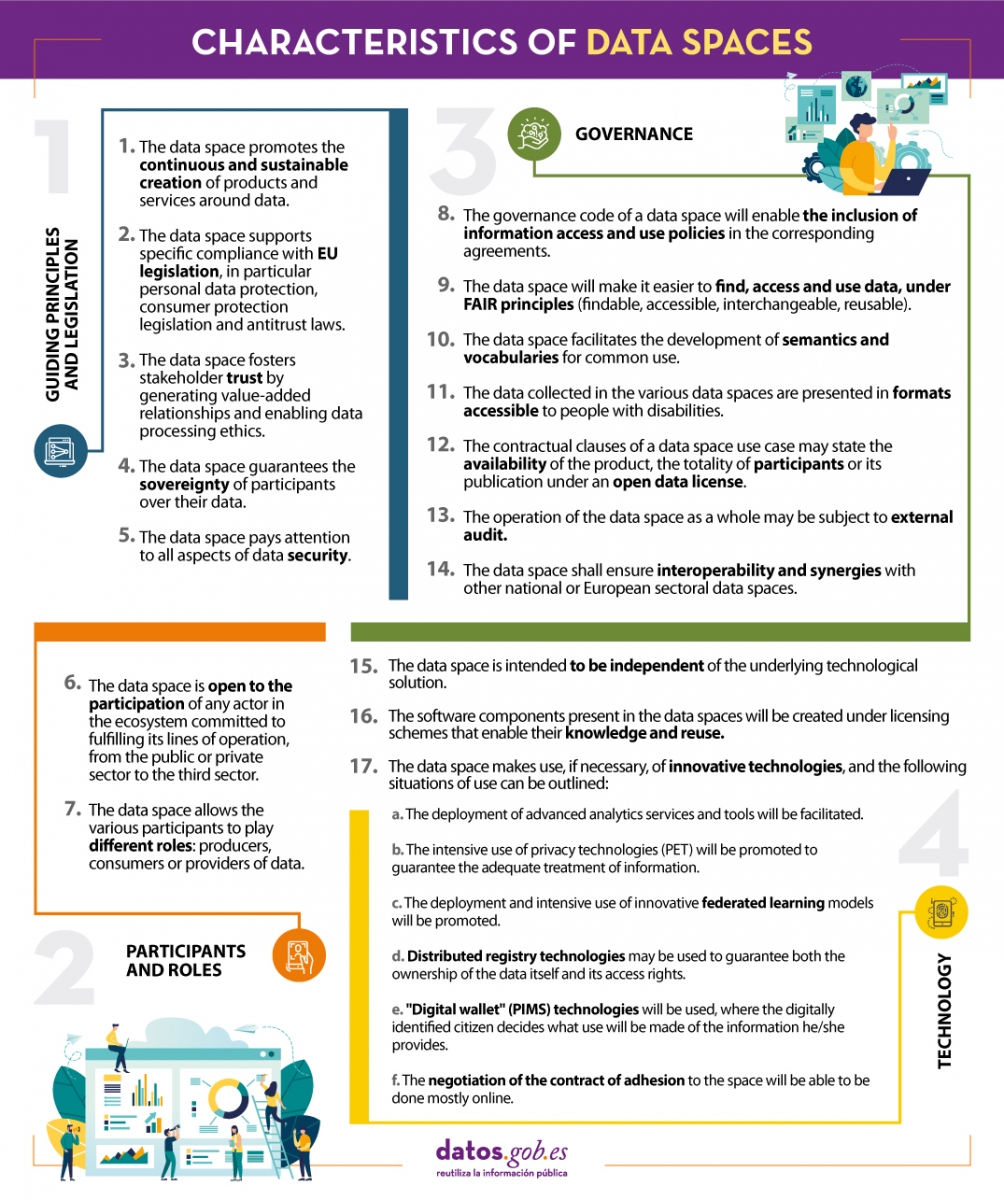
The following infographic shows the context driving the development of data spaces, focusing on some related European initiatives such as Gaia-X and ISDA. For more in-depth content you can read the following articles:
- The importance of deploying European Data Spaces
- Gaia-X and the drive for the data economy
- https://datos.gob.es/en/blog/ids-ram-reference-architecture-model-and-its-role-data-spaces
- The Data Office: the challenge of promoting the Data Economy
Click on the infographic to see it in full size and access the links:
Thanks to the efforts of the 160 organizations that publish data on the datos.gob.es platform, the National Open Data Catalog has reached 50,000 published datasets. Among them, we find datasets published by all levels of administration (state, regional and local), divided into the 22 thematic categories defined in the Technical Interoperability Standard (NTI, in Spanish acronyms), such as Public Sector, Society and Welfare, Environment or Economy.
In this article we want to zoom in on some of these datasets published by organizations belonging to the General State Administration (known as AGE in Spanish), based on three criteria:
- Data that receive a higher number of visits.
- High value and georeferenced data.
- Data with a high potential for reuse.
Most requested data
The Catalog's datasets recorded an average of more than 100,000 visits per month during the past year. These are some examples of the most visited datasets.
- Publisher: Ministry of Industry, Trade and Tourism
- Format: CSV, XLS, KML, XML, JSON and PNG.
Contains information on the price of the different types of fuels in Spanish gas stations, such as gasoline, diesel, liquefied petroleum gases or natural gas (both compressed and liquefied). It also includes the address and opening hours of the establishments.
This dataset is widely used in applications that report on fuel price variations, such as GeoGasolineras, from the Ministry for Ecological Transition and the Demographic Challenge, Search for cheap gas stations in Spain or Gasoline prices on the road, both from private companies.
- Publisher: Ministry of Health
- Format: CSV, HTML, PDF
It collects daily data on cases and incidence of the disease COVID-19, caused by the SARS-CoV-2 coronavirus. It also offers the historical series of cases by Autonomous Communities and Provinces. The data come from those reported by the health services of the Autonomous Communities themselves.
These data have been used to create different visualization tools that facilitate the understanding of the disease, such as the scorecard of the Ministry of Health itself, but it should be noted that there are numerous efforts at provincial and even local level in this area, some of which are included in this website.
- Publisher: Ministry of Territorial Policy and Public Function
- Format: RDF-XML y XLSX
DIR3 codes are three codes assigned respectively to the organizational units, their associated offices and the economic and budgetary management units of a public entity.
This set of data provides a unified and common inventory for the entire Administration, facilitating the distributed and co-responsible maintenance of information.
- Publisher: National Commission for Markets and Competition (CNMC)
- Format: XHTML, ZIP
This is a detailed list of information relating to the different telephone numbering ranges. It also includes the services provided by the teleoperator and the maximum prices, if regulated.
In addition to offering all the data from the CNMC's Telecommunications Numbering Registry by downloading the files in compressed format, the CNMC also provides access to a search engine. On the website of the National Commission for Markets and Competition, a search tool can be accessed to find out directly to which company each telephone number belongs.
High-value geo-referenced data
A georeferenced database is one where the exact location of its elements is defined based on a coordinate system. The referenced data allow us to locate the information on maps and to superimpose layers of information that allow us to perform more in-depth analyses. Below are 4 examples of georeferenced data that you can find in datos.gob.es.
- Publisher: Ministry of Transport, Mobility and Urban Agenda
- Format: XLS y ODS.
It offers urban information on 4,883 municipalities, including 100% of urban areas. Through a cartographic viewer, users can access the graphic and alphanumeric content of the Urban Information System.
This dataset allows a homogeneous and comparable approach to the Spanish urban reality. Among other uses, it offers information of interest in the field of decision making and urban planning.
- Publisher: National Center for Geographic Information
- Format: SHP
It includes geographic information related to municipalities and population entities. It includes the names, coordinates, population, etc. of each one of them.
The reference sources for the elaboration of this database are the Registry of Local Entities (MINHAP), the National Institute of Statistics and cartographic databases of the National Geographic Institute.
- Publisher: Geological and Mining Institute of Spain
- Format: MDB, XLS, HTML, JSON, KMZ, XML, SHP.
This is a database of seismogenic zones of the Iberian Peninsula and its territories of influence. Its use is intended for the calculation of the update of the hazard and earthquake risk map in Spain.
In this viewer you can see in a simple way the different points and know their level of danger.
- Publisher: National Parks Autonomous Agency
- Format: SHP, HTML
It collects the cartography of the natural vegetation and geological systems of the Spanish National Park Network. As it is homogeneous information, it allows comparisons to be made throughout the territory.
A cartographic viewer has also been developed that includes additional information on their location or the species of fauna and flora that inhabit them.
Data with high reuse potential
In datos.gob.es you can find versatile data with a multitude of formats that facilitate its reuse, many of them also georeferenced. Here are some examples:
- Publisher: National Library of Spain
- Format: CSV, HTML, JSON, ODS, plain, XML
Contains descriptions of Spanish libraries and documentation centers in any country. It includes information about their location, type of collection (books, reports, newspaper articles, maps, engravings, etc.) or the type of library (public, school, etc.), among other aspects.
Very useful for integration into tourist or citizen information applications that show the location of various services in a centralized way.
- Publisher: National Center for Geographic Information
- Format: SHP, atom, WFS, WMS
It includes geographic data related to municipal, provincial and autonomic precincts and their boundary lines. The scale used is 1:25,000.
It is very useful to know the space occupied by our towns and to know to which municipality a specific space belongs.
- Publisher: Guadalquivir Hydrographic Confederation
- Format: HTML, ODS, PNG, SHP
It provides the history of drought and water scarcity indicators in the Guadalquivir, Ceuta and Melilla river basin districts, as well as a map of the current status, with a monthly update frequency.
This is an essential dataset for monitoring the situation and promoting informed decision making.
- Publisher: National Institute of Statistics
- Format: CSV, JSON, XLSX, XLS, PC-Axis
The National Institute of Statistics offers open access to a large amount of data extracted from the surveys and studies it carries out periodically. One of them is this dataset containing information on the resident population in Spain. The data can be filtered by date, sex, generation (age on December 31), nationality and place of birth. The INE website includes a search engine to access the data more easily.
This dataset allows to know the characteristics of the Spanish population, and can be crossed with other data (economic, health, etc.) to generate a deeper knowledge of the society.
160 publishing organizations
This is just a small sample of some of the datasets available, but many more can be found in the National Catalog.
We currently have 160 publishers: 83 belonging to the General State Administration, 17 Autonomous Communities, 44 local entities, 11 universities and 1 private entity. In addition, there are 5 State institutions that do not fall into these categories, such as the Parliament of the Canary Islands.
The organizations that publish the most data in the Catalog are the autonomous administrations (45%), followed by the State (32%) and local administrations (15%), as shown in the following graph. You can obtain more information on the catalog through the scorecard.
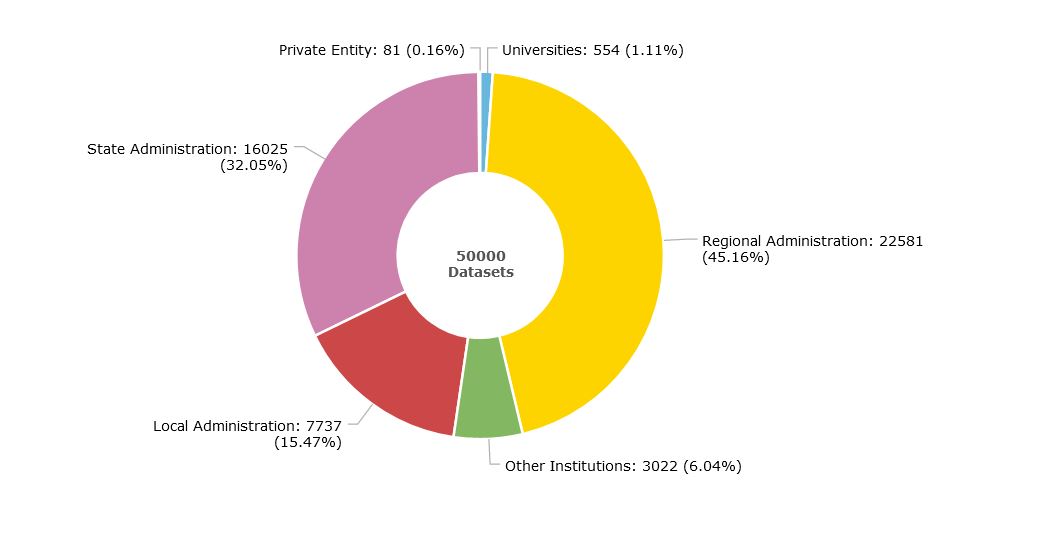
From datos.gob.es we invite you to explore our catalog. If you have any questions, you can write to us at contacto@datos.gob.es.
In 2015, the UN adopted the 2030 Agenda for Sustainable Development, an action plan made up of 17 global goals to eradicate poverty, protect the planet and ensure prosperity. This is what is known as the Sustainable Development Goals (SDGs).
In order to measure and evaluate the progress of the SDGs - in addition to their own development - accurate, up-to-date, sufficiently disaggregated, relevant, accessible and user-friendly data and statistics are needed. In other words, quality open data disaggregated by sex, age, municipality, etc. is needed.
In this regard, the UN itself has developed a set of indicators and statistical data aimed not only at monitoring progress, but also at informing policy and ensuring the accountability of all stakeholders. There are 232 indicators that refer to 169 targets. In addition, the Open SDG Data Hub portal provides geographically referenced data by target. Users can explore, analyse and use authoritative data sources on the SDGs to discover patterns, relationships and trends. For its part, the World Bank has an atlas where it presents interactive narratives and data visualizations on the SDGs, using its World Development Indicators database as a primary source.
But what if we want to delve deeper into what is happening in our country with respect to meeting the Sustainable Development Goals?
Resources related to the Sustainable Development Goals in Spain
Several organizations publish open data on the SDGs in our country. Below, we show you several examples at national and regional level.
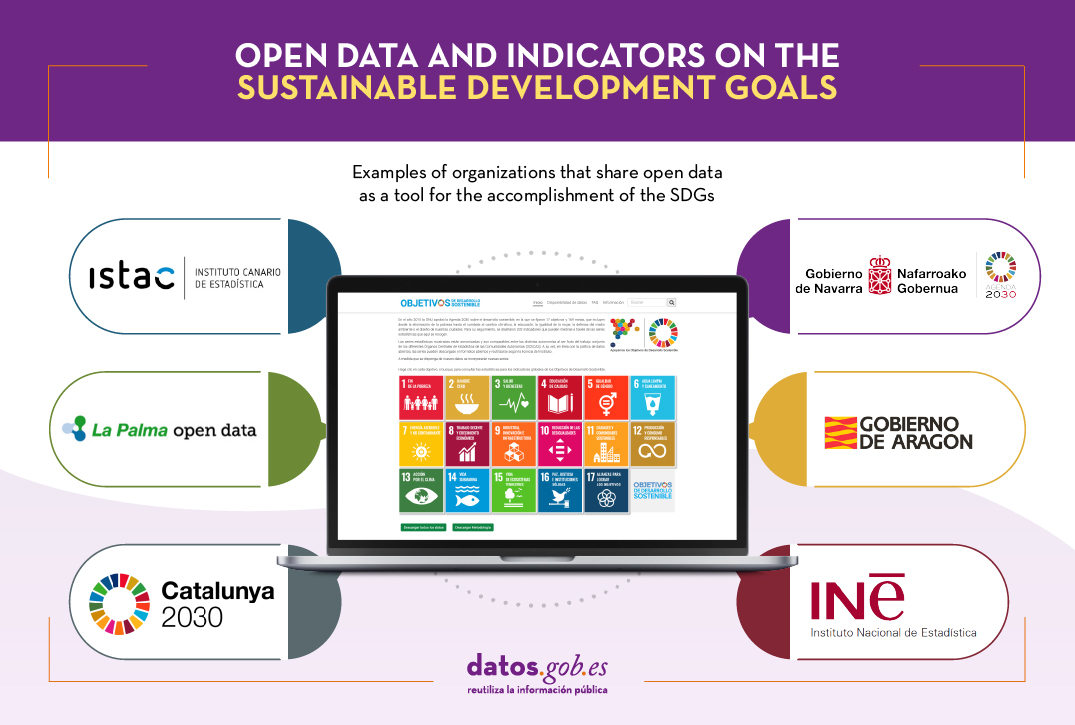
National Statistics Institute (INE)
Through its website, the INE has launched an electronic platform with updated statistical information about the global indicators established by the UN to monitor compliance with the SDGs.
When entering the available sub-indicators, the evolution of the indicator is shown graphically and, when possible, the breakdown by Autonomous Communities, age and sex. Data tables can also be accessed and downloaded in various formats (XLS, CSV, PC-Axis, etc.). These data are also available in our data catalog.
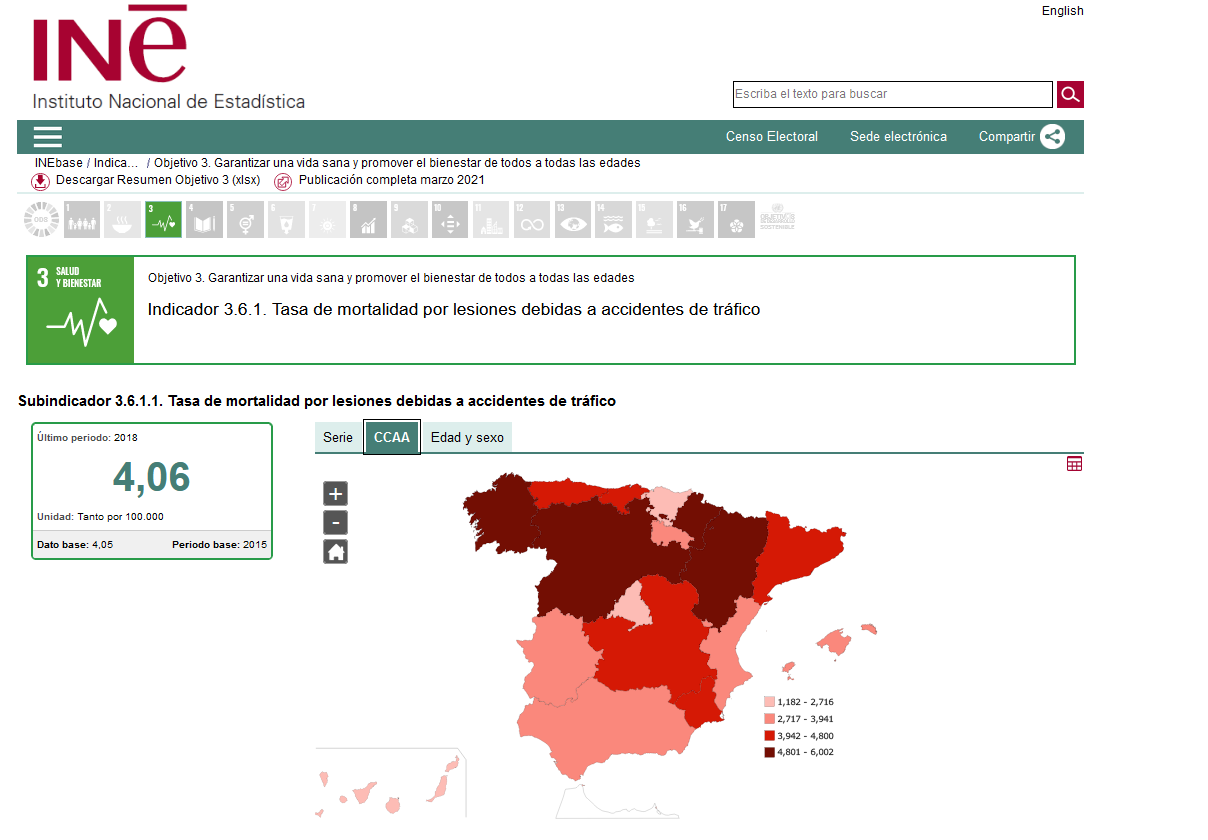
Canary Islands
The Canary Islands Statistics Institute (ISTAC) publishes in open format the indicators of compliance with the SDGs in the Canary Islands. The statistical series shown are harmonized and are comparable between the different autonomous regions as they are the result of the joint work of the different Central Statistical Bodies of the Autonomous Communities (OCECAS).
The ISTAC has created a tutorial showing how to reuse the data hosted in the application.
You can download the data from the platform itself or here.
Navarra
The Government of Navarra has launched a website to show its progress in achieving the Sustainable Development Goals (SDGs). It shows the activities being carried out to meet each of the 17 goals and their impact through graphs and indicators that show the region's progress in the different areas. It includes summaries by region. The data can be downloaded here.
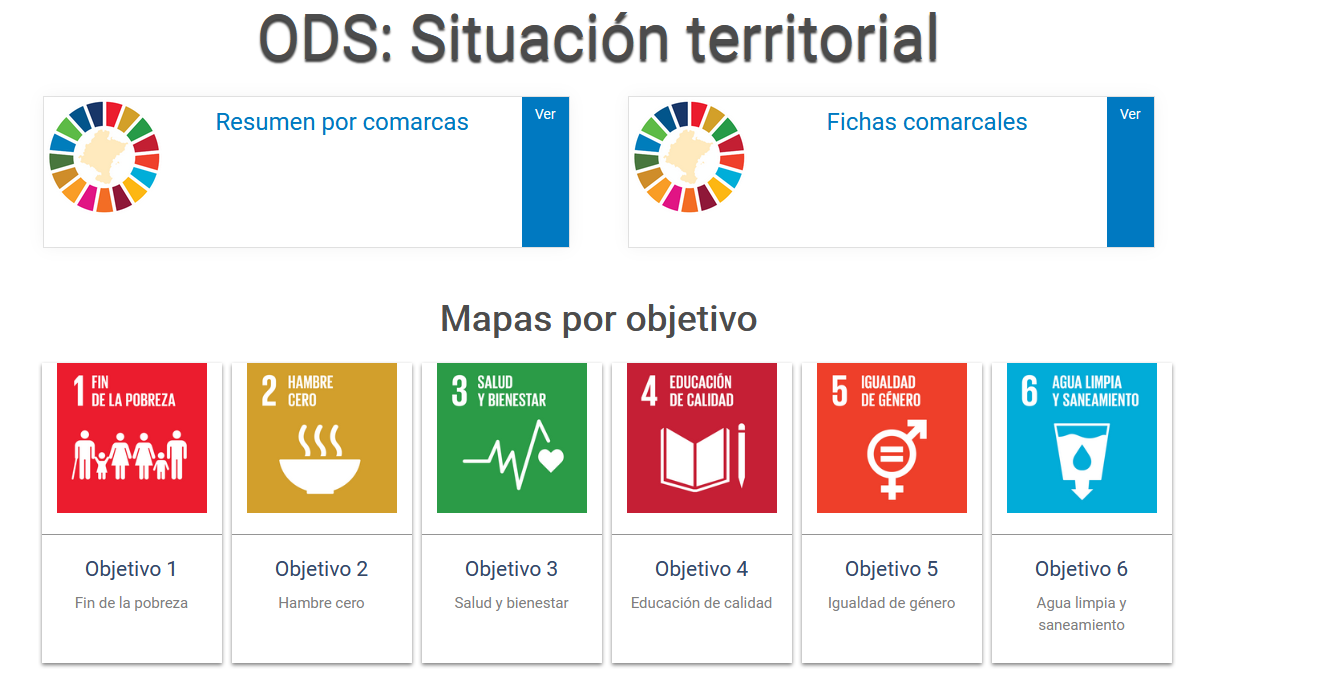
La Palma
The Open Data La Palma portal allows you to explore the available data based on the categories of the Sustainable Development Goals (SDGs). On the homepage of the portal you can click on the image of each goal to see the available data related to it. It is not about indicators, but a different way of organizing the available data.
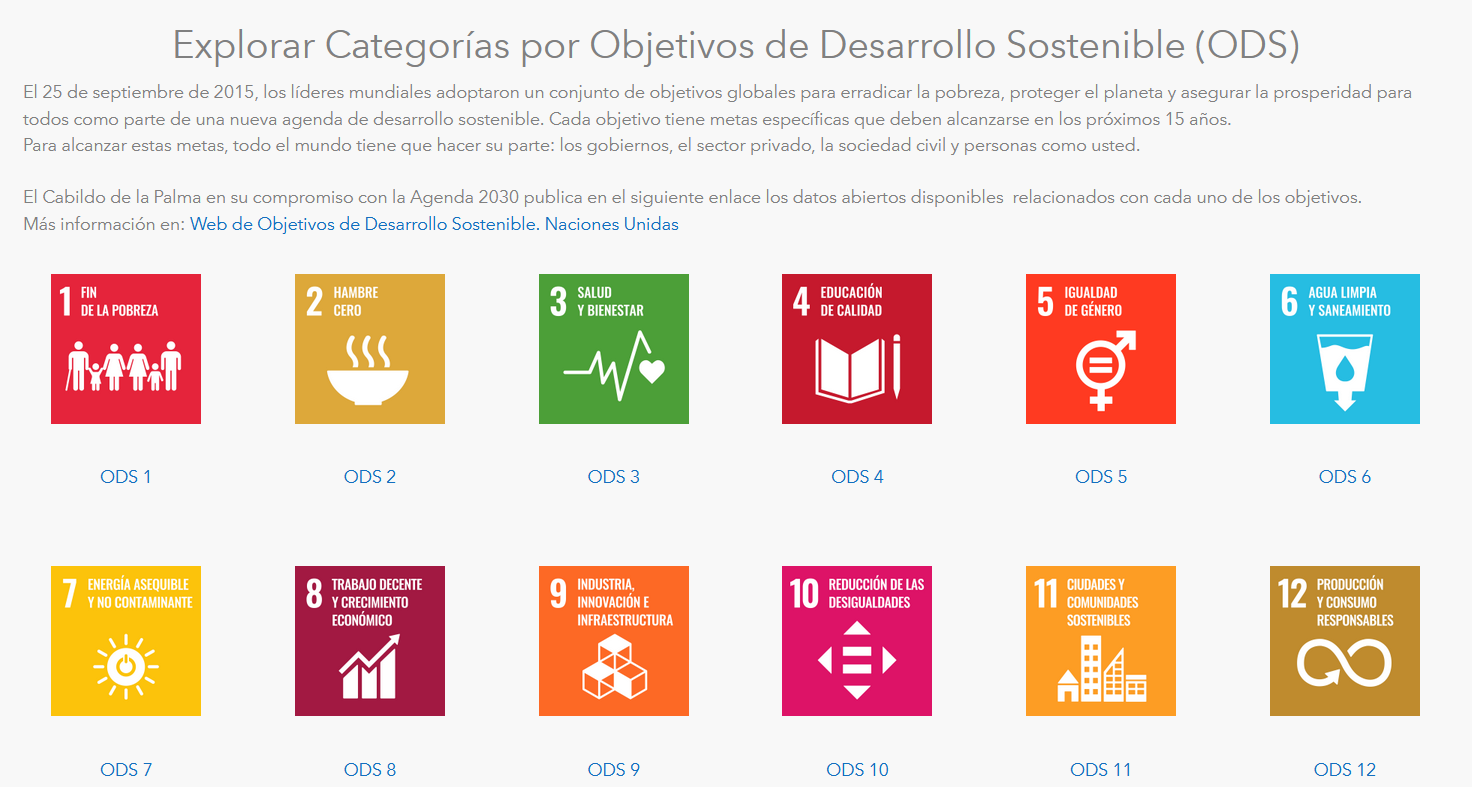
Aragón
Thanks to the work of the Aragonese Institute of Statistics, this website has been created where you can access different resources related to each of the objectives, including an Excel file with all the regional indicators. The methodological sheet is also available in Word format.
Catalonia
Since 2019, Catalonia's annual statistical action programs incorporate in the official statistics the development, maintenance, updating and dissemination of the integrated system of SDG indicators for the region. To do so, they take as a reference the indicators published by Eurostat and their criteria of quality, robustness and methodological adequacy. On this website you can see the results and download the data in CSV format.
In addition to these examples, there are many initiatives that also share open data on compliance with the SDGs on their websites. This is the case of Andalusia and the Basque Country.
In short, open data is essential for monitoring the progress achieved in the different programs. Therefore, more and more organizations are publishing data in this sense, data that are essential to know the inequalities and that policy makers can seek more accurate solutions. This will help advance implementation and the goal of achieving a fairer world for all.
Content prepared by the datos.gob.es team.
Throughout history, geospatial data have allowed humankind to better understand its environment. When we talk about geographic or spatial data, we refer to data "that implicitly or explicitly refer to a location relative to the Earth", according to the Spanish Standard UNE 148004:2018. Generally, these data are accessible on maps, visualisers, mobile devices and other media helping us to move and manage the territory in a more efficient way, thus achieving greater progress.
Today, geospatial data remains of particular importance. According to a study by the European Open Data Portal, geospatial data is the second most reused data, behind only statistical data. Both individuals and companies use them to create tools to help citizens in their daily lives - when choosing the most appropriate route to reach a destination -, in management situations - such as fighting a fire - or when they want to disconnect through recreational elements - such as strategy games.
Given this demand, it is not surprising that there is a need for infrastructures that allow us to access this type of information in a harmonised and interoperable way, facilitating its reuse.
What is a Spatial Data Infrastructure (SDI)?
According to the website of the Ministry for Ecological Transition and the Demographic Challenge, a Spatial Data Infrastructure (SDI or IDE in Spanish) "is an information system made up of a set of resources dedicated to managing Geographic Information, available on the Internet, which meet a series of interoperability conditions, and which allow a user, using a simple browser, to use and combine them according to their needs". Through an SDI, geographic information is accessed on the Internet through web services and is catalogued (with metadata) for its location or search, considering regulations, technical documents, international norms and standards that guarantee its interoperability and harmonisation.
It is therefore a mechanism that facilitates the task of searching and accessing geographic data in a uniform manner. This is essential to promote their reuse through the development of digital solutions.
The Spatial Data Infrastructure of Spain (IDEE, in Spanish)
In Spain there are a multitude of geoportals and SDI nodes at state, regional and local level, which are centralised through the geoportal of the Spatial Data Infrastructure of Spain (IDEE). This is a project designed to merge the geographic data with which the Public Administrations of Spain work under the umbrella of the LISIGE and the Regulations of the INSPIRE Directive (Infrastructure for Spatial Information in Europe).
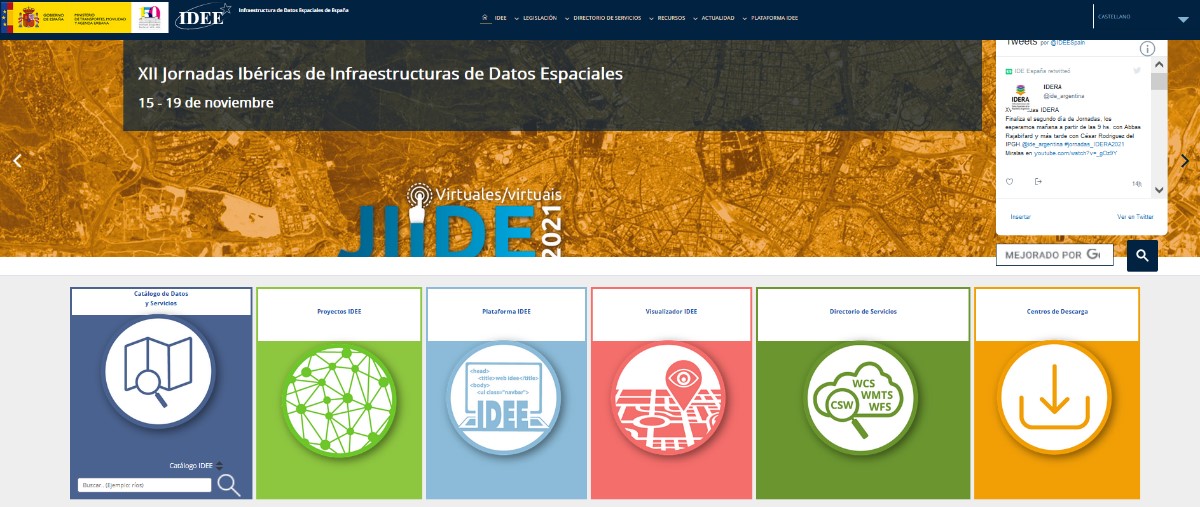
IDEE Geoportal: https://www.idee.es/
The main objective of the IDEE is to publish official geographic information for viewing and downloading and to offer the possibility of locating the data through its descriptions (metadata), so that the data is accessible, machine-readable, easy to locate and reusable. Today, re-use is generally free of charge. To achieve this goal, the NSDI is based on international standards and European regulations that make data interoperable and accessible through open formats.
In charge of coordinating the IDEE is the Consejo Directivo de la Infraestructura de Información Geográfica de España (CODIIGE), created by the Consejo Superior Geográfico, a governing body belonging to the Ministry of Transport, Mobility and Urban Agenda (MITMA). The CODIIGE is made up of representatives of the three levels of the Administration, experts from the Commissions of the High Geographic Council and experts in environmental policies.
The IDEE is part of the European SDI and publishes approximately 250 resources on the European Commission's Geoportal classified by subject.
Who participates in the IDEE?
As mentioned above, the IDEE is made up of the organisations responsible for the data that the European Commission has classified, identified and documented through the INSPIRE Directive Regulation 1089/2010, such as, for example:
- General Directorate of Cadastre, which publishes cadastral plots, buildings and addresses freely and free of charge through viewing and downloading services, allowing this data to be consulted on sites such as the Cadastre's Electronic Headquarters. It is worth highlighting its coordination with the Land Registry. Now any citizen can voluntarily request in a sale or purchase, or at any time, without waiting for the registration of a new act, the incorporation in the Land Registry of a cadastral graphic representation.
- MAPA and MITECO, which work jointly on the publication of data classified as priority data by the European Commission. Its publication is materialised in its IDE geoportal.
- National Centre for Geographic Information (CNIG), responsible for the Cartociudad project, which compiles and publishes freely and free of charge the addresses from the G.D. of Cadastre, the Post Office Group, the National Statistics Institute, the National Geographic Institute, the Autonomous Communities such as the Basque Country, the Community of Navarre, the Community of Valencia, La Rioja, the Balearic Islands and the Community of Madrid, and at a local level, the City Council of Cáceres and the Provincial Council of Madrid.
- Ministry for Ecological Transition and the Demographic Challenge, with its Gas Stations Geoportal application, for searching and visualising service stations, facilitates locating the most economical stations closest to the user through the use of location data.
Other organisations and some of their SDI projects can be consulted on this map.
Other services and web resources of the IDEE
Some time ago we wrote an article about the services and resources included in the IDEE Geoportal, and since then, this geoportal has been complemented with the recent publication of the IDEE Platform, whose main objective is to collect, for the developers of the geospatial community, software development initiatives, thus facilitating the reuse of resources.
In the resources section of the geoportal and the IDEE platform, sections continue to be offered that provide added value beyond the datasets themselves; these are resources published by different administrations and international organisations to facilitate decision-making. To the sections analysed in the previous article, we must add as a novelty a section dedicated to Open Resources on COVID-19, whose incorporation is due to the importance that spatial data are having in the management of this health crisis.
The IDEE also has a blog where questions of interest to all users interested in geographic data are collected.
Want to know more about IDEs?
The Ministry of Transport, Mobility and Urban Agenda has recently published a guide on Spatial Data Infrastructures, which covers the basic concepts, the legal framework, the web technologies needed to implement such an infrastructure, web services, information on how to catalogue geographic information (metadata) and other related topics.
In addition, if you are interested in publishing geographic data, we encourage you to read our "Practical Guide to Publishing Spatial Data", where you will find good practices and guidelines to facilitate the publication of spatial data efficiently on the Internet.
Content prepared by the datos.gob.es team.
